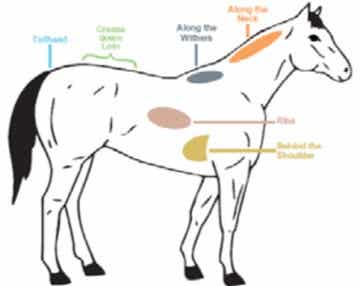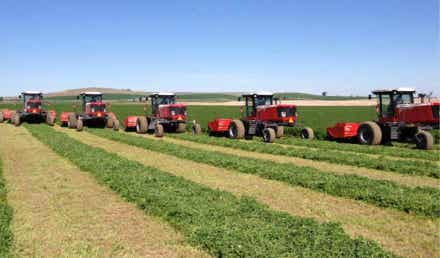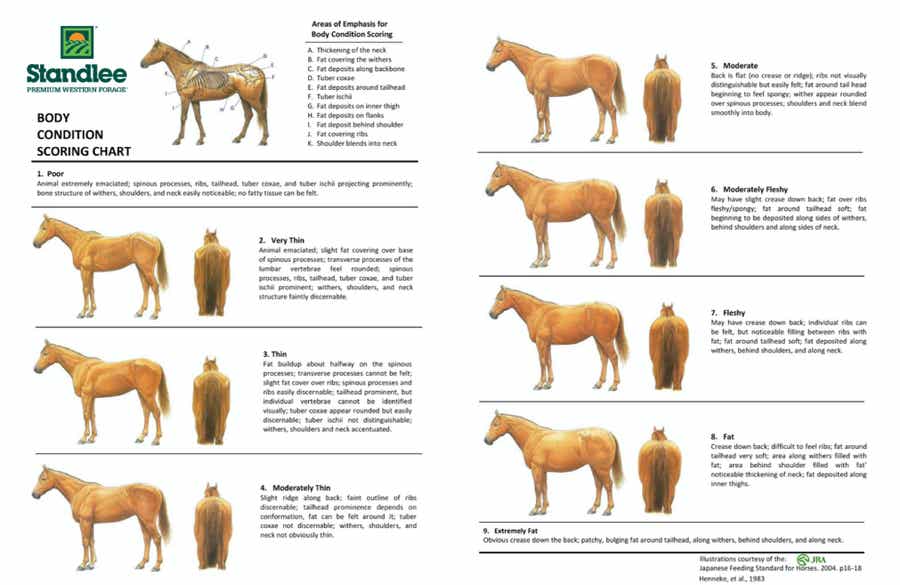MANAGING BODY CONDITION WITH FORAGE
Dr. Stephen Duren, Performance Horse Nutrition

Many horse owners struggle with the body condition of their horses. Some horses seem to gain condition easily and become overweight. While other horses seem to eat and eat while not gaining body condition and become thin. So how do we keep horses in the correct body condition? The following article will give a brief overview of proper body condition along with tips to properly manage body condition with forage.
Most horse owners do not have a scale at their farm or stable that is large enough to determine the body weight of a horse. Weight tapes offer a means of “calculating” body weight, but are subject to error with horses that have different sizes, body styles or builds. The goal with determining body weight is ultimately to make feeding and exercise decisions that keep horses in the proper condition. A Body Condition Scoring (BCS) system has been developed to help horse owners visually determine if their horses is overweight, underweight or in ideal condition. This visual evaluation of horses is an advantage since scales are not required. Body condition scoring uses a numeric scoring system from 1 to 9, to classify horses from underweight to overweight. The body condition scoring (BCS) system assigns a numerical value to fat deposition as it occurs in various places on the horse’s body. The system works by assessing fat both visually and by palpation (examination by touch), in each the following areas: the loin, ribs, tail head, withers, neck, and behind the shoulders.
Horses with a BCS of 3 or less are considered underweight. Horses with a BCS of 4-6 are ideal. A BCS of 7-8 is considered overweight, and a BCS greater than 8 is considered obese. For more information about Body Condition Scoring, see the last 2 pages of this paper.
So how do we manage the body condition and ultimately the body weight of our horses? Just like your doctor has told you on routine health visits, body condition and body weight is controlled by a combination of diet and exercise. For horses, the same principles control body condition – diet and exercise. If we want a horse to lose condition we need to feed fewer calories and expend more calories through exercise. The amount of exercise a horse gets is controlled by stable routine including the amount of turnout and the amount of training or forced exercise that is provided to the horse. Unfortunately, many of these factors can be out of your control or dictated by your work or family schedule. Feeding, on the other hand, is something that happens every day. Feeding is also something that you can control.
Horses eat from 1.5% to 3% of their body weight per day in feed. For a 1,000 lb. horse, this translates into 15 to 30 lbs. of feed per day. The vast majority of our horses will consume more forage (hay/pasture) in their diet compared to grain. When horse owners contemplate controlling the weight of their horses, they often think about increasing or decreasing the amount of grain. While this makes sense, we can often make more progress by modifying the forage feeding program of a horse’s diet since it is the majority of the feed consumed. This makes the type and amount of forage provided a key to controlling the body condition of a horse. Remember... Always start by providing the highest quality forage available to your animal!

The type of forage is one factor that dictates calorie intake. Generally, grass hays such at timothy and orchard grass contain fewer calories compared to legumes such as alfalfa. Mixed hays containing a combination of grass and alfalfa would be intermediate in calorie content. So a horse that is in a low body condition and needs to gain weight would benefit calorically from the addition of some alfalfa into the diet. Conversely, a horse that is overweight or that is in a high body condition would benefit from more grass hay in the diet compared to alfalfa.
Maturity of the forage will also dictate calorie content. Forage that is harvested when the plant is very tall and mature contains a lower calorie content compared to hay that is cut and baled when the plant is short and immature. Many people feel the cutting of hay (1st, 2nd, etc.) dictates calorie content, but this is not correct. It is not the cutting of the hay that dictates calorie content, but instead the height or maturity of the plant at the time of harvest that determines calorie content. For horses that require weight gain to increase body condition, feeding short, immature forage will provide the most calories. For overweight horses, very mature, tall forage will give the horse plenty to chew on, but provide few calories. Feeding this type of hay should ultimately result in weight loss for overweight horses. Standlee forage is typically harvested early to maximize nutrient content and energy.
Another factor that determines calorie intake is the amount of forage provided in the diet. A horse that is in a low body condition will often gain condition simply by providing more forage or a longer grazing session. Increasing the forage to the point that forage is available free-choice is always the first step in feeding a thin horse. For a horse that is overweight or in a high body condition, we can limit the amount of forage to 1.5% of body weight. You will need to weigh the amount of forage to ensure you are feeding at the target intake. When forage must be carefully measured, it is often an advantage to feed forage cubes or pellets since they can be easily weighed in a scoop or feed bucket. Controlling pasture intake is more difficult. From my experience, overweight horses do not self-regulate on pasture. The only methods to reduce intake of pasture are to limit the amount of time spent grazing or to limit the amount of intake with a grazing muzzle. Horse owners often feel “sorry” for horses that are required to wear a grazing muzzle. These horse owners will remove the muzzle and give the horse a short grazing session without the muzzle. Unfortunately, in these short grazing sessions horses will super-compensate and consume a massive amount of forage which defeats the purpose of using a grazing muzzle in the first place.
Controlling body condition is important for the health and longevity of any horse. By selecting the type of forage, the maturity of the forage and controlling the intake of the forage it is possible to optimize the body condition of your horse. It makes sense to optimize body condition with wise forage feeding decisions since forage (hay/pasture) is the major component of the diet for most horses. To determine the best forage type to feed your animal, use the Standlee Forage Finder®. For more forage and nutritional information, visit standleeforage.com or contact Standlee Premium Products at 800-398-0819.


